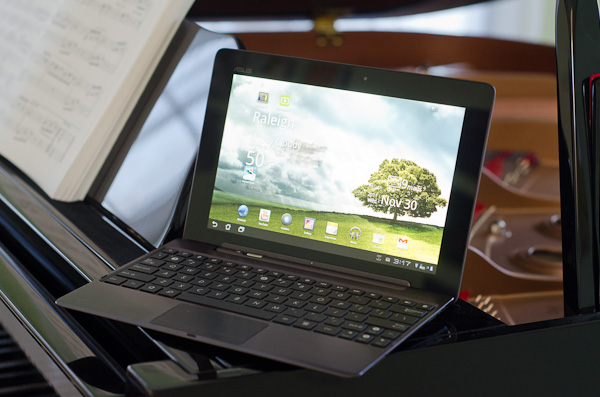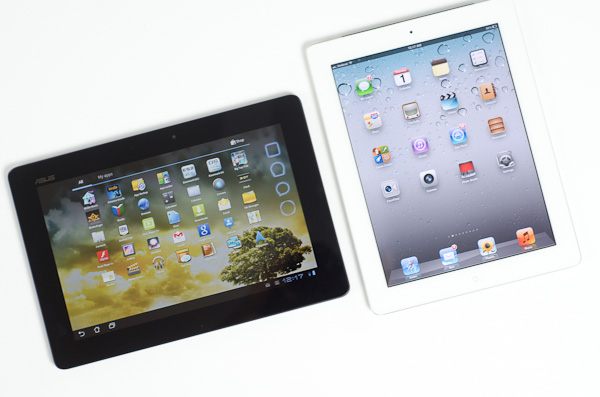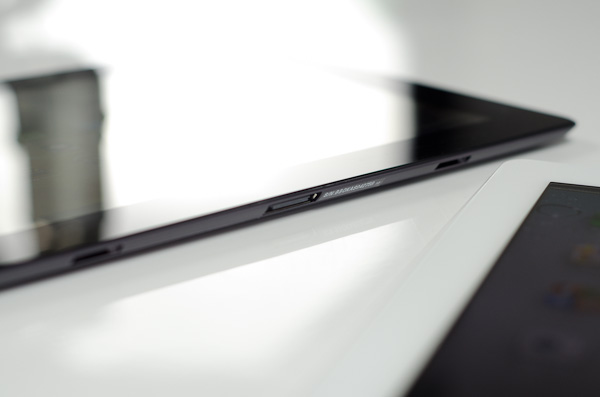ASUS Eee Pad Transformer Prime & NVIDIA Tegra 3 Review
by Anand Lal Shimpi on December 1, 2011 1:00 AM ESTGoing from making good motherboards to going head to head with Samsung for Google's affection is a pretty big step for ASUS, but it's one that the company has taken and done very well with. None of its peers have made the same transition, especially not while continuing to thrive in their existing businesses. I don't think anyone can say that ASUS' motherboards have suffered over the past several years as the company has transitioned, much like Apple, into the world of being a mobile computer manufacturer.
ASUS' first Android tablet was a knock out of the park. The original Eee Pad Transformer gave us a glimpse of the future with its keyboard dock while delivering a good Honeycomb experience for $100 less than the competition. As many sacrifices as ASUS had to make to reach its price point, the original Eee Pad remains one of the best Honeycomb tablets on the market. But the show must go on and simply being the cheapest on the block doesn't work anymore, particularly with companies like Amazon redefining what cheap means. It was time for a new flagship and today we have that tablet:
Priced at $499 the Eee Pad Transformer Prime will be available in North America during the week of 12/19.
| Tablet Specification Comparison | ||||||
| ASUS Eee Pad Transformer | ASUS Eee Pad Transformer Prime | Apple iPad 2 | Samsung Galaxy Tab 10.1 | |||
| Dimensions | 271mm x 175mm x 12.95mm | 263 x 180.8 x 8.3mm | 241.2 x 185.7 x 8.8mm | 256.6 x 172.9 x 8.6mm | ||
| Display | 10.1-inch 1280 x 800 | 10.1-inch 1280 x 800 Super IPS+ | 9.7-inch 1024 x 768 IPS | 10.1-inch 1280 x 800 PLS | ||
| Weight | 675g | 586g | 601g | 565g | ||
| Processor | 1GHz NVIDIA Tegra 2 (2 x Cortex A9) | 1.3GHz NVIDIA Tegra 3 (4 x Cortex A9) | 1GHz Apple A5 (2 x Cortex A9) | 1GHz NVIDIA Tegra 2 (2 x Cortex A9) | ||
| Memory | 1GB | 1GB | 512MB | 1GB | ||
| Storage | 16GB + microSD card | 32GB/64GB + microSD slot | 16GB | 16GB | ||
| Pricing | $399 | $499/$599 | $499 | $499 | ||
Whereas Motorola was first out of the gate with a Tegra 2 based Honeycomb tablet, ASUS is done with playing second fiddle. ASUS is NVIDIA's first and only launch partner for its new quad-core Tegra 3 SoC. The Google OS of choice is still Honeycomb, although I hear the Eee Pad Transformer Prime also happens to be Google's development and validation vehicle for Ice Cream Sandwich on Tegra 3.
The Prime is everything the original Eee Pad Transformer was missing. It's thinner than an iPad 2 or Galaxy Tab and built out of aluminum and glass. Other than minor details like the buttons and connectors, your hands never touch plastic when using the Transformer Prime. Even those plastic buttons look and feel great. The tablet is just beautiful. It echoes the design language of ASUS' Zenbook, but without the disappointment in the panel department. ASUS' latest tablet actually has the best display of any tablet we've reviewed, including those made by Apple and Samsung (more on this later).
The usual suspects are carefully placed around the perimeter of the Transformer Prime. Held in landscape mode the power/lock button is at the top left corner, with the volume rocker perpendicular to and just below it on the left side. Also along the left side is a micro HDMI output for display cloning and a microSD card slot. A standard 1/8" headset jack finds itself on the right side of the tablet, and ASUS' standard dock connector is bottom center. The original Eee Pad had two speaker grills, while the Prime has a single, larger speaker on the back of the device. Audio output is surprisingly full but the tablet doesn't get loud enough to overpower a noisy environment.
ASUS went a little crazy with the rubber stoppers all over the Prime. The dock connector and its two mechanical retention/secure points are plugged with these things, as is the USB port on the optional transformer dock.
Just like last time, the Eee Pad Transformer Prime can be mated to an optional keyboard dock for an extra $149. The dock adds a QWERTY keyboard, trackpad, an SD card reader, USB port and comes with its own 22Wh battery. The dock's battery not only powers itself but it can charge the Prime's battery, almost doubling battery life.
We'll spend the next several pages going through every detail of the new Eee Pad Transformer Prime as well as NVIDIA's Tegra 3 SoC, but on the surface, ASUS has built a formidable tablet. How does it fare under closer scrutiny? Very well it turns out...
A Lesson in How Not to Launch a Product
Of all of the things ASUS has learned from running the PC side of its business it seems that the proper way to launch a brand new platform didn't translate over to its tablet business. I received the Eee Pad Transformer Prime 39 hours ago and the NDA lifted just now. While this is not atypical for many mobile launches, ASUS should know better.
To do a thorough review of any product the minimum time we need to adequately integrate that product into our daily routine and come away with a deep understanding of the product is at least a week. I say that's the minimum amount of time because if you give us more, then we can do even better analysis and spend even more time bug hunting. Most of the players in the mobile space don't really get this, and as a result they are complicit in the disappointing amount of analysis that's done on their hardware. This will change as time goes on, but I honestly expected more from ASUS.
My WiFi is Broken
What's one of the biggest risks when you give reviewers only 39 hours to review a product? If something is wrong with the review sample, there's hardly any time to fix it. This time I drew the short straw and my Transformer Prime review sample arrived with highly questionable WiFi performance. Both range and performance were impacted by whatever plagued my sample. I got less range and much lower performance than the original Eee Pad Transformer regardless of location or wireless access point. How bad? My Prime had difficulty sustaining more than 2Mbps over WiFi. ASUS and NVIDIA both sent me proof that there wasn't something wrong with other samples, and from their data it looks like the WiFi stack in the Prime is at least comparable to the original Transformer. The problem may just be limited to my unit, although I tend to believe that if something goes wrong once, it's bound to go wrong more than once.
Based on the fact that wireless performance improves when docked and upstream speeds are almost normal, if I had to guess I'd say that the receive antenna is either not fully connected or somehow impaired from doing its normal duty. I should have a replacement unit in by tomorrow, but unfortunately that means you won't see any WiFi dependent results here.
ASUS chose Broadcom's BCM4329 for WiFi/Bluetooth duty. Although the controller supports both 2.4GHz and 5GHz operation, the Prime is limited to work on 2.4GHz networks. The rest of the design is pretty standard - you get a single spatial stream at a maximum of 72Mbps. Real world performance, if ASUS/NVIDIA's numbers are to be believed, should top out somewhere in the upper 30Mbps area.
Update: ASUS got us a fixed unit, be sure to check out our follow-up here.




















204 Comments
View All Comments
steven75 - Saturday, December 3, 2011 - link
But what reason can you give for not getting an ipad? Too much software selection? Too great of an ecosystem? Too much wireless video streaming to your TV? Too high of resale value? Too easy to use?Curious minds want to know!
BillyBobMcgrath - Monday, December 5, 2011 - link
How about bad value for money? For the price of a 32GB Prime you get a 16GB iPad 2. It has roughly half the specs of the Prime: only 0.5GB memory, dual core processor v.s. quad core, lower resolution and screen size (which is REALLY annoying for watching 16:9 ratio videos, which is to say more than 1/2 shows/movies you can buy/download) and lack of expansion slots.In terms of software, iPad is smoother than android but at the same time you get a very limited browsing experience with iOS. I know HTML5 is the "future" but at the present is still dominant and will be for a while.
As for apps, whilst there are less app choice, It has a good range - you may have less choice in each department than iOS but you will always find apps suitable for your needs.
Build quality, at least for the prime, is also a lot better than the iPad's. Whilst both use aluminum instead of cheap plastic, the prime uses Gorilla glass rather than normal glass.
For $500, the transformer prime gives you a much, much better product. Apple products are very good and generally blows away low-mid range non apple products but when you compare apple's products to similarly priced alternatives, they just don't deliver acceptable quality for your money.
For example, a current generation MacBook pro 15" costs £1.6K. A HP 15" with virtually identical specs costs £800. The inclusion iOS does not justify a 100% markup on a windows PC. FOr £1.6k you can buy a laptop much, much more powerful than the £2k MacBook pro. The iOS may be better but is not worth £800. Furthermore to get full functionality out of a Mac you have to buy windows for bootcamp, which is another £120. By choosing a similarly priced alternative to apple products you "miss out" on an apple OS but gain much better specd products. I don't mind paying more for a better product but I expect the quality of the product to match the price and you just don't get that with Apple.
simad57 - Friday, December 2, 2011 - link
One criticism of the original Transformer was that the charging cable was too short. Have they addressed that issue with the Prime? If not - is a USB extension cable a reasonable solution to address a too short cable or is there an issue with the about of current being pushed down the cable to charge the tablet in a shorter time than the mini usb.Stas - Friday, December 2, 2011 - link
That is a fantastic screen! I'm very surprised and impressed.user777 - Sunday, December 4, 2011 - link
1) G3 USB stick testThere were a lot of questions regarding the G3 version of the tablet.
Is there a possibility to test any G3 USB stick on the Transformer Prime dock (example 50 USD/euro G3 usb stick from Archos G9)? It would answer all these questions.
2) Skype video call test
Skype is may be the most popular video app available for a lot of Android devices. Would it be possible to make a Skype video conference call test and confirm if the Skype app works with video on Transformer Prime?
3) MX Video Player test
I really like the MX Video Player which also has full support for multi-core processors, subtitles, mkv/m2ts/mp4/... file formats, etc. Is it possible to test MX Video player too?
user777 - Sunday, December 4, 2011 - link
The possibility to play multi format video files is indeed excellent feature of the Transformer Prime.Since the video file are quite large in size playing them from a home DLNA server via WiFi is important too (example Vuse torrent client DLNA server and playing by any third party DLNA client app like Skifta, iMediaShare, Bubble UPnP). Is it possible to test the DLNA video streaming of 720p/1080p videos?
lancedal - Sunday, December 4, 2011 - link
for tablet/smartphone market, except Apple. Why? because it's so software/os dependent. With an open platform like Android/Window, it's very hard to harvest the extra resources.If you look at the PC market, the quad-core is for heavy gaming and server while the dual-core is the most generic CPU for every laptop/desktop out there. And that is with a matured market with matured OS and application.
I would doubt that Apple would go quad-core, but they are the only one can do it because they control both software and hardware. The rest? stick with dual.
ProDigit - Sunday, December 4, 2011 - link
Having a quadcore fast machine is good!However, there are not sufficient programs out there, really needing all that performance!
Most programs are smaller apps you can run with a single core running half the CPU speed!
And most games, 3D games run perfectly fine on a cortex A8 or A9 processor.
A pitty that software for Android is lacking behind!
Lucian Armasu - Sunday, December 4, 2011 - link
That's the whole Asus Transformer Prime. It can use an integrated keyboard dock, to look much like a Zenbook. The hardware is similar.kamm2 - Monday, December 5, 2011 - link
"Scrolling is rarely as smooth as I'd like it to be via the dock's trackpad. Many times the gesture just won't register on the trackpad or the trackpad will detect my two fingers but it won't scroll."We have this problem with my wife's Eee PC netbook. It is very annoying. We are looking to replace her aging notebook and will not be buying one without scroll bars on the trackpad. The probably means no Asus. The trackpad is also hyper sensitive so it makes accidental touches while typing a nightmare. There seems to be no sweet spot when adjusting the sensitivity. This is in contrast to the trackpad on her first generation Eee PC which is excellent.